Essential Pickleball Accessories: Paddles, Balls, Nets, and More
Introduction And Guide Pickleball To Accessories
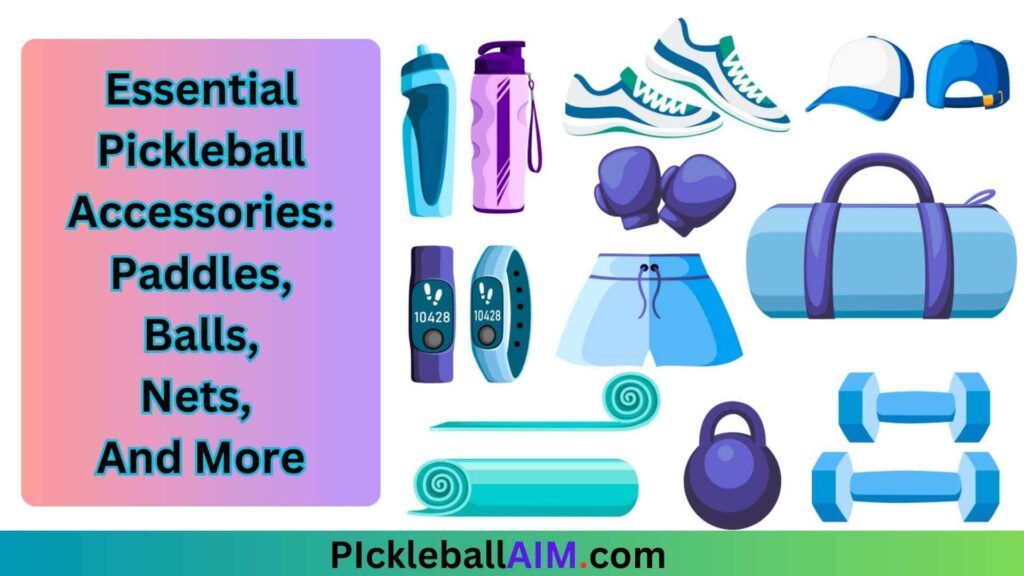
“Pickleball accessories” refer to a variety of items and equipment that are used to enhance the experience of playing pickleball, a popular paddle sport that combines elements of tennis, badminton, and table tennis. These accessories can improve gameplay, provide protection, and increase the overall enjoyment of the sport. Some common pickleball accessories include:
- Pickleball Paddles: These are specialized paddles used to hit the pickleball. They come in various materials, sizes, and weights to cater to different player preferences and skill levels.
- Pickleballs: The pickleball itself is a perforated plastic ball, similar to a wiffle ball, designed to provide a balance of speed, bounce, and control during play.
- Pickleball Bags: Pickleball bags are designed to carry all the necessary equipment, such as paddles, balls, and other accessories. They usually have compartments to keep things organized and protected.
- Pickleball Nets: Portable pickleball nets are used to set up the court for play. They are typically lightweight and easy to assemble.
- Pickleball Court Tape: Court tape is used to mark the boundaries of the pickleball court on any flat surface, such as concrete or a gym floor.
- Pickleball Gloves: Some players use gloves to get a better grip on the paddle and to protect their hands during extended play.
- Pickleball Apparel: Specialized clothing designed for pickleball players, such as shirts, shorts, and skirts, which are comfortable and allow for ease of movement.
- Pickleball Hat/Visor: A hat or visor can provide protection from the sun during outdoor play.
- Pickleball Shoes: Shoes designed for pickleball provide stability, support, and traction on the court to help prevent slips and falls.
- Pickleball Elbow Brace: Some players may use an elbow brace to support and protect their elbows during play, especially if they have a history of tennis elbow or similar conditions.
- Pickleball Dampeners: These small accessories can be attached to the strings of the pickleball paddle to reduce vibrations and make the paddle feel more comfortable during hits.
- Pickleball Scorekeepers: Scorekeeping devices can help players keep track of the score during games.
Remember that while these accessories can be beneficial, the most essential items to play pickleball are a pickleball paddle, pickleballs, and a pickleball court. All other accessories are optional and can be chosen based on personal preferences and needs.
1. Pickleball Paddles
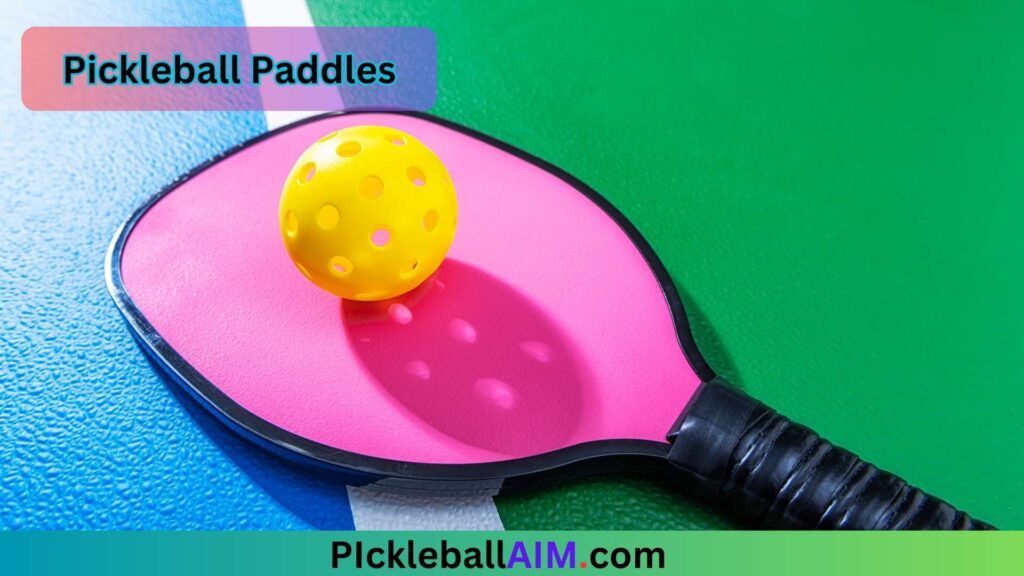
Pickleball paddles are essential equipment used in the sport of pickleball to hit the ball. They are designed to provide players with control, power, and maneuverability during gameplay. Below is a detailed explanation of pickleball paddles and their key characteristics:
Function and Purpose:
Pickleball paddles are the primary tool used by players to strike the pickleball and send it over the net to the opposing side of the court. The design and construction of the paddle influence factors such as ball control, shot accuracy, power generation, and spin potential.
Materials:
Pickleball paddles can be made from various materials, each offering distinct characteristics. Common materials include:
- Wood: Traditional wooden paddles are less common nowadays, but they can still be found. They tend to be heavier and offer less power and control compared to modern materials.
- Composite: Paddles made from composite materials, such as fiberglass and carbon fiber, are popular due to their balanced performance. They provide a good combination of power and control and are favored by many players.
- Polymer (Polypropylene): Paddles made from polypropylene are known for their durability and affordability. They are often used by recreational players and beginners.
- Graphite: Graphite paddles are known for their lightweight nature and maneuverability. They offer excellent control and are preferred by players who prioritize finesse over power.
Sizes:
Pickleball paddles come in various sizes, mainly differing in width. The most common sizes are typically around 7.3 to 8 inches wide. A larger surface area generally provides a larger sweet spot, making it easier to connect with the ball. However, larger paddles may sacrifice some maneuverability.
Weights:
Paddles also vary in weight, with options typically ranging from 6 to 14 ounces1Ounces are a unit of measurement commonly used to quantify weight or volume, with one ounce equal to approximately 28.35 grams or 1/16th of a pound.. Lighter paddles offer greater maneuverability and control, allowing for quicker reactions and better placement. Heavier paddles, on the other hand, can generate more power but may require more effort to swing.
Grip Size:
The grip size of a pickleball paddle refers to the circumference of the handle. It is important to choose a grip size that fits comfortably in the player’s hand. An improper grip size can lead to discomfort, reduced control, and even potential injuries. Common grip sizes are small, medium, and large.
Player Preferences and Skill Levels:
Different players have varying preferences and playstyles. Some players may prioritize power, while others may prefer finesse and control. Additionally, players at different skill levels may benefit from specific paddle characteristics. Beginners may benefit from a paddle with a larger sweet spot and more forgiving features, while advanced players may seek paddles tailored to their specific playing style.
In conclusion, pickleball paddles are crucial tools that players use to engage in the sport effectively. The choice of paddle material, size, weight, and grip size should be based on the individual player’s preferences, style, and skill level. It is advisable for players to try out different paddles to find the one that best suits their playing needs and helps them enjoy the game to the fullest.
2. Pickleballs (Balls): The Essential Playing Component
Pickleballs are a fundamental element of the game, serving as the primary playing ball for pickleball matches. Understanding their composition, design, and characteristics is essential for players to enjoy the game to its fullest.
Composition and Material:
Pickleballs are made from plastic and are commonly designed with a two-piece construction. The plastic material used is usually durable and lightweight, allowing for optimal performance on the court. The composition ensures that the ball is resilient to withstand the impact of paddle hits while maintaining its shape and playability over time.
Perforated Design:
A defining feature of pickleballs is their perforated design. Similar to a wiffle ball used in various other sports, the pickleball has evenly spaced holes throughout its surface. These perforations help reduce wind resistance and provide a unique flight pattern, ensuring that the ball remains stable during play and allowing players to have better control over its trajectory.
Size and Weight:
Pickleballs are slightly larger than traditional wiffle balls, with a standard diameter of 2.874 inches (approximately 73mm). The weight of a pickleball typically ranges from 0.78 to 0.935 ounces (about 22 to 26.5 grams). The size and weight are standardized to maintain uniformity and consistency across matches and tournaments.
Color Variations:
Traditionally, pickleballs were primarily available in a single color, which was typically a bright shade of green. However, as the sport gained popularity, manufacturers began producing pickleballs in a variety of colors, including yellow, white, and orange. Each color offers good visibility against different backgrounds, making it easier for players to track the ball during intense gameplay.
Balance of Speed, Bounce, and Control:
The design and construction of the pickleball aim to strike a balance between speed, bounce, and control. The ball’s perforations and weight contribute to its controlled flight path and the ability to produce various shot types. Additionally, the plastic material ensures a reasonable bounce, allowing for engaging rallies and strategic plays. The balance between these factors makes pickleball an enjoyable and accessible sport for players of all ages and skill levels.
Pickleballs are the heart of the pickleball game. Their perforated plastic design, standardized size, and weight, along with the balance of speed, bounce, and control, make them suitable for casual play, competitive matches, and tournaments. Whether playing indoors or outdoors, the design of the pickleball ensures a dynamic and engaging experience for players and is a key factor in the sport’s widespread appeal.
3. Pickleball Bags: Designed for Convenience and Organization
Pickleball bags are an essential accessory for players of this popular paddle sport. These specially designed bags serve the purpose of carrying all the necessary equipment required for playing pickleball, ensuring that players can easily transport their gear to and from the court.
Purpose and Importance:
Pickleball bags play a crucial role in the convenience and organization of a pickleball player’s equipment. Instead of carrying paddles, balls, and other accessories separately, a pickleball bag provides a dedicated and compact solution to keep everything in one place. This not only makes it easier to carry all the gear but also helps in preventing the loss or misplacement of items during transit.
Capacity and Compartments:
Pickleball bags are designed with ample storage capacity to accommodate multiple paddles, pickleballs, and various accessories. They come in different sizes, ranging from small sling bags for a single paddle to larger backpack-style bags that can hold multiple paddles, balls, and other personal belongings.
To keep things organized, pickleball bags are equipped with multiple compartments and pockets. These compartments serve various purposes, such as:
- Paddle Compartments: Dedicated sections with padding to securely hold and protect the paddles from any damage during transportation.
- Ball Pouches: Specialized pockets designed to keep pickleballs separate and secure, preventing them from rolling around and potentially getting lost.
- Accessory Pockets: Additional pockets to store smaller items like water bottles, towels, wristbands, sunscreen, keys, phones, and wallets.
- Ventilation Panels: Some bags may have ventilation panels or mesh sections to allow airflow and prevent moisture build-up, which is especially useful if players sweat during gameplay.
Durability and Comfort:
Pickleball bags are typically made from durable materials, such as high-quality nylon or polyester, which ensures that they can withstand the rigors of regular use and last for an extended period. Reinforced stitching and sturdy zippers are common features to enhance durability.
Comfort is also a consideration in pickleball bag design. Bags are equipped with padded shoulder straps and handles, making it easier to carry the equipment, particularly for players who need to walk or bike to the court.
Styles and Designs:
Pickleball bags come in various styles and designs, catering to different tastes and preferences. Some players prefer simple and sleek designs, while others may opt for more colorful and eye-catching patterns.
Additionally, some brands offer customizations and personalization options, allowing players to add their names, logos, or other graphics to the bag.
Read Also: How to Find Your Opponent’s Weak Spots in Pickleball
4. Pickleball Nets
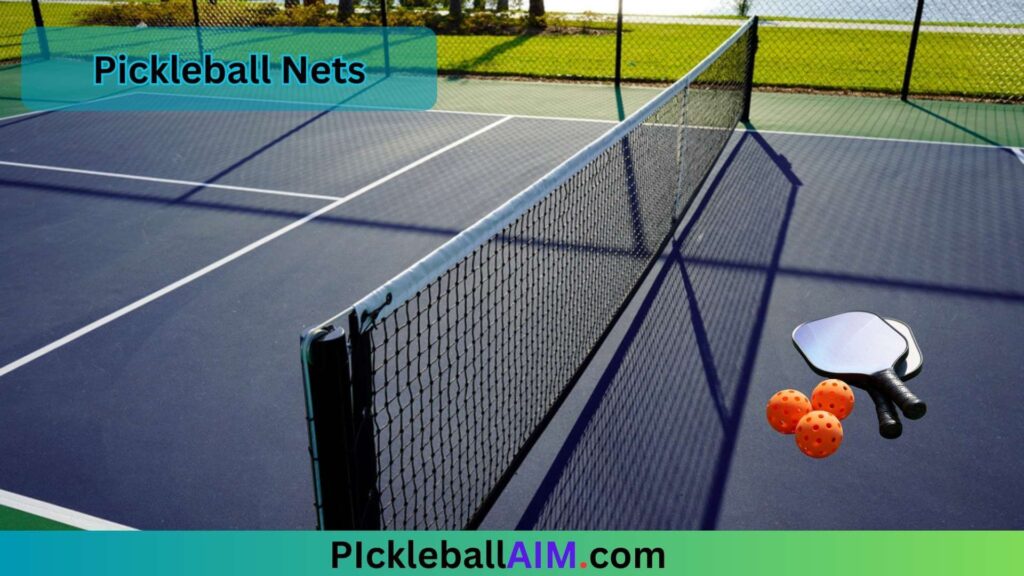
Pickleball nets are an essential accessory for setting up a pickleball court and facilitating the gameplay. These nets are designed specifically for pickleball and are different from nets used in other sports like tennis or badminton. Here’s a complete explanation of portable pickleball nets:
Purpose and Function:
The primary purpose of a pickleball net is to divide the court into two halves, creating separate playing areas for each team. The net is placed at the center of the court, and players on either side must hit the ball over the net to their opponents’ side during the game. The net acts as a barrier and determines the boundary for the game.
Portable Design:
Portable pickleball nets are designed to be lightweight and easily movable. Unlike fixed nets used in other sports, pickleball nets can be set up and taken down quickly, making them ideal for both indoor and outdoor play. They are usually made of metal or composite materials to keep them lightweight yet sturdy.
Easy Assembly:
Setting up a portable pickleball net is a straightforward process that doesn’t require any specialized tools or expertise. The net comes with a frame that can be unfolded or assembled, and the net itself is attached to the frame. The frame may have interlocking parts or snap-lock mechanisms, ensuring a secure fit during play.
Height and Dimensions:
According to official pickleball rules, the net should be 34 inches (86.4 cm) high at the center, and its ends should be slightly lower to create a slight arc. The width of the net should be 20 feet (6.1 meters), the same as the official pickleball court width. Portable pickleball nets are designed to meet these height and width specifications accurately.
Portability and Storage:
One of the key advantages of portable pickleball nets is their portability and easy storage. Once the game is over, the net can be disassembled or folded into a compact size. Many portable nets come with carrying bags or cases, making it convenient to transport and store them when not in use. This feature is particularly useful for players who want to set up temporary pickleball courts in various locations.
Durability and Stability:
Although portable, these nets are built to withstand the rigors of regular use. They are designed to remain stable during play, even in outdoor conditions where wind or slight impacts might occur. The materials used are chosen to ensure durability and longevity.
Compliance with Regulations:
Official pickleball organizations have specific rules and regulations regarding net height, width, and other aspects. Portable pickleball nets manufactured by reputable brands typically comply with these regulations, ensuring fair and standardized gameplay.
In summary, portable pickleball nets are essential accessories for playing pickleball. Their lightweight, easy assembly, and portability make them convenient for players who want to enjoy pickleball in various locations. With their sturdy construction and adherence to regulations, these nets offer a reliable and enjoyable pickleball experience for players of all skill levels.
Read Also: Basic Accessories for Every Pickleballer
5. Pickleball Court Tape: Marking Boundaries for Play
What is Pickleball Court Tape?
Pickleball court tape is a specialized adhesive tape used to mark the boundaries of a pickleball court on any flat surface, such as concrete, asphalt, or a gym floor. It serves as a temporary solution to create a pickleball court without the need for permanent markings, making it ideal for indoor and outdoor locations that may have other uses when not playing pickleball.
Importance of Court Tape
Properly marked boundaries are crucial in pickleball to ensure fair play and maintain the integrity of the game. The tape clearly defines the court’s dimensions, including the sidelines, baseline, and non-volley zone (commonly known as the “kitchen”). Having well-defined boundaries also helps prevent disputes during matches, as players can easily determine whether a shot is in or out of bounds.
Choosing the Right Tape
When selecting pickleball court tape, several factors should be considered:
- Surface Compatibility: Ensure the tape is suitable for the surface on which it will be applied, whether concrete, gym floors, or other materials. It should adhere well without damaging the surface when removed.
- Visibility and Durability: Opt for brightly colored tape that is easily visible, even from a distance. The tape should be durable enough to withstand regular foot traffic and minor scuffing during play.
- Width and Length: Pickleball court tape typically comes in various widths and lengths. It’s essential to choose tape that is wide enough to be noticeable but not so wide that it disrupts play or feels intrusive on the court.
How to Use Pickleball Court Tape
Applying pickleball court tape requires attention to detail and precision to ensure accurate court dimensions. Here’s a step-by-step guide:
- Clean the Surface: Thoroughly clean the playing surface to remove any dirt, debris, or moisture. A clean surface will help the tape adhere better and last longer.
- Measure and Mark Court Dimensions: Use a tape measure to determine the proper dimensions of the pickleball court. For official play, the court should be 20 feet wide and 44 feet long, with non-volley zone lines situated 7 feet from the net on both sides.
- Begin Taping the Court: Start at one corner of the court and carefully lay down the tape along the boundary lines. Use a steady hand to ensure straight lines and avoid any gaps or overlaps in the tape.
- Non-Volley Zone (NVZ) Tape: If desired, use a separate color of tape to mark the non-volley zone lines, which extend 7 feet from the net on both sides. This area has special rules, so distinguishing it with a different color helps players adhere to the regulations.
- Check for Accuracy: Once the tape is applied, double-check all the dimensions and lines for accuracy. Minor adjustments can be made at this stage to fix any inaccuracies.
Removing the Tape
When the pickleball session is over, the court tape can be easily removed without leaving residue or causing damage to the surface. Simply peel off the tape carefully, and any leftover adhesive can be cleaned using appropriate methods, depending on the surface material.
Using pickleball court tape allows players to set up and enjoy the game in various locations without the need for permanent court markings. It’s a convenient solution that ensures a fair and organized playing environment for pickleball enthusiasts of all skill levels.
Read Also: 7 Steps to Power Serving in Pickleball
6. Pickleball Gloves: Enhancing Grip and Hand Protection
Pickleball gloves are specialized accessories that some players choose to use during gameplay. These gloves serve two main purposes: improving grip and providing hand protection. Let’s take a closer look at each of these aspects:
Enhancing Grip:
Pickleball gloves are designed with materials that offer enhanced grip properties. They typically feature synthetic materials, such as leather or high-quality synthetic leather, on the palms and fingers. These materials have a tacky or textured surface that helps players maintain a firm hold on the pickleball paddle, even during intense rallies or when their hands get sweaty. The improved grip can result in better control over shots and reduce the likelihood of the paddle slipping out of the player’s hand.
Hand Protection:
During extended pickleball sessions or competitive play, players may experience friction and pressure on their hands due to repetitive movements like gripping the paddle and hitting the ball. This can lead to discomfort, blisters, or calluses. Pickleball gloves offer an additional layer of protection, acting as a barrier between the player’s skin and the paddle’s handle. The cushioning and padding in the glove’s design can help minimize the impact of these repetitive movements, reducing the risk of developing blisters or sore spots on the hands.
It’s important to note that not all pickleball players choose to wear gloves, and their use is entirely optional. Many players find that they have a natural grip that works well for them, or they may prefer the tactile sensation of holding the paddle directly with their hands. However, for individuals who experience sweaty palms, hand discomfort, or want extra control over the paddle, gloves can be a valuable addition to their pickleball gear.
When selecting pickleball gloves, players should consider factors such as size, fit, material, and breathability. A proper fit ensures that the gloves stay securely in place and do not interfere with the player’s movements. Additionally, breathable materials can help keep the hands cool and comfortable during play.
Overall, pickleball gloves are a personal preference, and players can choose to try them out to see if they enhance their gameplay and overall comfort during extended sessions on the court.
7. Pickleball Apparel
Pickleball apparel refers to specialized clothing designed specifically for pickleball players. This clothing is tailored to meet the unique demands of the sport, offering a combination of comfort, functionality, and style. Pickleball apparel typically includes shirts, shorts, and skirts, which are selected to enhance the player’s performance on the court.
Shirts
Pickleball shirts are designed with features that prioritize the player’s comfort and performance during the game. They are usually made from moisture-wicking materials, such as polyester or other synthetic blends. Moisture-wicking fabrics draw sweat away from the skin, helping to keep players dry and comfortable even during intense play.
These shirts may also have ventilation panels or mesh inserts strategically placed to enhance breathability, allowing air circulation and preventing overheating. The fit of the shirts is often tailored to allow a full range of motion without being too tight or restrictive.
Some pickleball shirts may also come with UV protection, especially for outdoor play. This feature helps shield players from the harmful effects of the sun’s rays during extended matches.
Shorts
Pickleball shorts are designed to offer both comfort and mobility on the court. They are typically made from lightweight and flexible materials that allow players to move freely without hindrance. The length of the shorts is generally chosen to strike a balance between providing adequate coverage and ensuring ease of movement.
Similar to shirts, moisture-wicking properties are essential for pickleball shorts to keep players cool and dry. Many shorts come with an elastic waistband and drawstrings to provide a secure and adjustable fit.
Pickleball shorts may also have pockets for convenience, allowing players to carry small items like balls or a towel while playing.
Skirts
Pickleball skirts are mainly designed for female players who prefer a more traditional and stylish look. Like shorts, skirts are made with breathable, moisture-wicking fabrics to keep players comfortable during matches.
The length of pickleball skirts is usually designed to comply with the rules and etiquette of the sport, ensuring they do not hinder movement or become a distraction during play. They often have built-in shorts or compression shorts for added coverage and modesty.
Benefits of Pickleball Apparel
Pickleball apparel offers several benefits to players:
- Enhanced Performance: The clothing’s design and materials allow players to move freely and comfortably, improving their agility, speed, and overall performance on the court.
- Moisture Management: The moisture-wicking properties of the fabric keep players dry by pulling sweat away from the skin, which is especially important during intense matches or hot weather.
- Breathability: Ventilation features and mesh panels promote airflow, preventing overheating and ensuring players stay cool and fresh during long games.
- Protection: Some pickleball apparel may include features like UV protection, guarding players from the sun’s harmful rays during outdoor play.
- Style and Identity: Specialized pickleball clothing helps players identify with the sport and fosters a sense of belonging within the pickleball community.
Overall, investing in proper pickleball apparel ensures that players are well-prepared, comfortable, and able to focus solely on enjoying the game and improving their skills without unnecessary distractions.
Read Also: The Vibrant Yellow Outdoor Pickleball: Enhancing Visibility and Playability
8. Pickleball Hat/Visor: Protection from the Sun during Outdoor Play
Importance of Sun Protection in Pickleball:
Playing pickleball often involves spending extended periods outdoors, exposed to the sun’s harmful ultraviolet (UV) rays. Sun protection is crucial to prevent sunburn, skin damage, and reduce the risk of skin cancer. Wearing a hat or visor is an effective way to shield the face, scalp, and eyes from direct sunlight while playing.
Functionality of Pickleball Hat/Visor:
A pickleball hat or visor is designed to provide adequate protection while ensuring comfort during play. They typically have wide brims that extend over the forehead and eyes, offering shade to the face and reducing glare. This design helps prevent sunburn on the face, especially the nose, ears, and the delicate skin around the eyes.
Material and Breathability:
Pickleball hats and visors are commonly made from lightweight, moisture-wicking materials that allow air circulation and keep the head cool during physical activity. The breathability of the fabric prevents excessive sweating, which can be uncomfortable during intense gameplay.
Adjustable Fit:
Most pickleball hats and visors come with adjustable straps, buckles, or Velcro closures at the back. This feature allows players to customize the fit according to their head size and ensures a secure and comfortable fit throughout the game.
Sweat Absorption:
During active pickleball matches, players may perspire, and sweat can trickle down the forehead and into the eyes, affecting vision and comfort. The sweat-wicking properties of pickleball hats/visors help absorb moisture, keeping the forehead dry and preventing sweat from interfering with the game.
Eye Protection:
In addition to shielding the face, a visor can also offer some protection to the eyes from direct sunlight. While it may not completely replace sunglasses, it can help reduce glare and eye strain, making it easier to track the pickleball and maintain good visibility on the court.
Versatility:
Pickleball hats and visors are not only useful for playing pickleball but can be worn during various outdoor activities, such as hiking, biking, or gardening. Their versatility makes them a practical accessory for anyone spending time in the sun.
Style and Personalization:
Pickleball hats and visors are available in a wide range of colors and styles, allowing players to express their personality while adhering to functional sun protection. Whether it’s a baseball-style cap or a wide-brimmed visor, players can choose an option that suits their preference and style.
In conclusion, wearing a pickleball hat or visor during outdoor play is essential to protect yourself from the sun’s harmful rays, prevent sunburn, and reduce the risk of skin damage. These accessories offer functional benefits, such as shade, sweat absorption, and eye protection, while being comfortable and adjustable to fit individual needs. With their versatility and style options, pickleball hats and visors are practical accessories for any pickleball player engaging in outdoor matches and other sun-exposed activities.
Read Also: 5 Pickleball Tactics to Instantly Improve Your Game
9. Pickleball Shoes
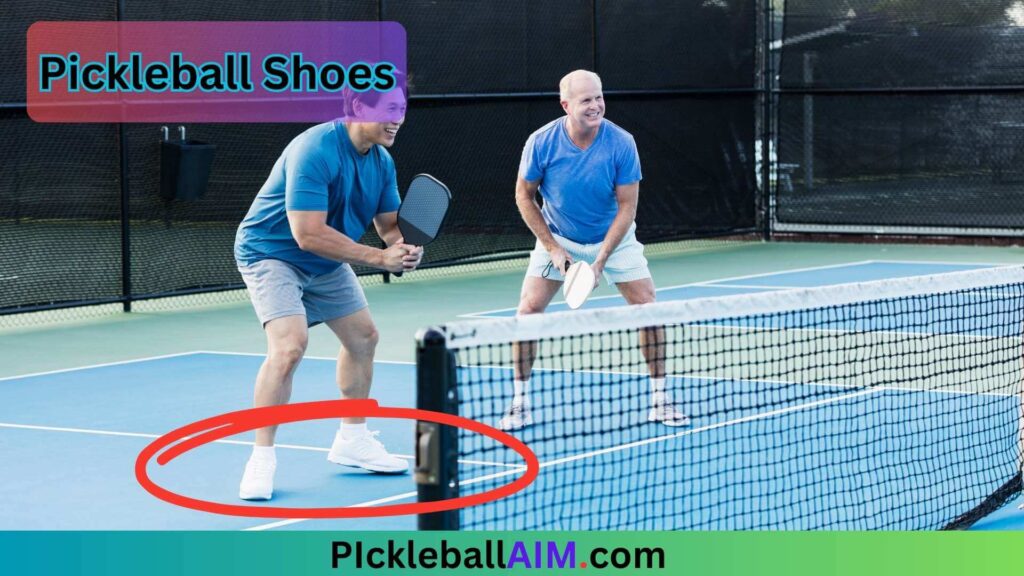
Pickleball shoes are a specialized type of footwear designed specifically for playing pickleball, a fast-paced paddle sport that involves quick lateral movements and sudden stops. These shoes are crafted to enhance the player’s performance, comfort, and safety on the pickleball court.
Stability:
One of the primary features of pickleball shoes is their focus on providing stability to the player. The sport requires frequent changes in direction and lateral movements, which can put stress on the ankles and feet. Pickleball shoes are designed with features like a low-to-the-ground profile, a secure fit, and reinforced sides to prevent excessive rolling of the ankles and provide stability during these movements.
Support:
Pickleball shoes offer excellent support to the feet, arches, and heels. The repetitive motions involved in pickleball can strain the foot’s ligaments and muscles. Therefore, these shoes often have cushioned insoles, padded collars, and reinforced midsoles to reduce impact and provide support, especially during prolonged play.
Traction:
Traction is crucial in pickleball shoes to help players maintain balance and prevent slips and falls on the court. The outsoles of pickleball shoes are made from materials with high grip properties, such as gum rubber or non-marking rubber. These outsoles feature tread patterns that offer multidirectional traction, enabling players to quickly change direction and stop with confidence.
Durability:
Pickleball shoes are typically built to be durable and withstand the demands of the sport. The frequent lateral movements, sudden stops, and fast-paced play can put considerable strain on the shoes. Therefore, they are constructed using robust materials and reinforced in areas prone to wear and tear, ensuring longevity and value for money.
Lightweight:
Lightweight design is an essential characteristic of pickleball shoes as it allows players to move quickly and effortlessly across the court. Heavy shoes can slow down players and lead to fatigue during extended matches. By prioritizing lightweight materials, pickleball shoes help players maintain their agility and mobility throughout the game.
Breathability:
Pickleball shoes often incorporate breathable materials in their construction to enhance airflow and keep the feet cool and dry during intense play. Improved breathability reduces the risk of discomfort, blisters, and odor caused by excessive sweating.
In conclusion, investing in a good pair of pickleball shoes is crucial for any player serious about the sport. These shoes provide the necessary stability, support, traction, durability, and comfort to help players perform at their best while reducing the risk of injuries, slips, and falls on the pickleball court. It’s essential to choose pickleball shoes that fit well and suit your playing style to maximize the benefits they offer during matches and practice sessions.
10. Pickleball Elbow Brace: Supporting and Protecting Elbows During Play
Purpose of a Pickleball Elbow Brace:
A pickleball elbow brace is a specialized accessory designed to provide support and protection to the elbow joint during pickleball play. It is particularly useful for players who have a history of tennis elbow or similar conditions that may cause discomfort or pain in the elbow area while playing.
Addressing Tennis Elbow and Related Conditions:
Tennis elbow, medically known as lateral epicondylitis, is a common overuse injury that affects the tendons on the outer side of the elbow. It often occurs due to repetitive movements involving the forearm muscles, such as those used in pickleball swings. The strain and stress from these repetitive motions can lead to inflammation and pain in the elbow area.
Elbow Brace Design and Function:
A pickleball elbow brace typically wraps around the forearm, just below the elbow joint. It may have adjustable straps or compression features to allow players to customize the fit according to their comfort level and support needs. The brace is designed to exert gentle pressure on the forearm muscles and tendons, helping to reduce the strain and vibration experienced during pickleball shots.
Providing Support and Stability:
During a pickleball game, players engage in repetitive hitting motions that involve wrist and forearm movements. These actions can put additional stress on the elbow joint, leading to discomfort or exacerbating existing conditions like tennis elbow. The elbow brace aims to provide support and stability to the affected area, minimizing excessive movement and reducing the risk of injury.
Easing Pain and Discomfort:
For players who already have tennis elbow or other elbow-related issues, the brace can help alleviate pain and discomfort during play. The compression provided by the brace can improve blood circulation to the affected area, promoting faster recovery and reducing swelling or inflammation.
Injury Prevention and Long-term Benefits:
Even for players without pre-existing elbow conditions, using an elbow brace as a preventive measure can be beneficial. By reducing the strain on the elbow joint during intense gameplay, the brace helps minimize the risk of developing tennis elbow or similar overuse injuries in the long run.
Consulting with a Medical Professional:
While a pickleball elbow brace can be a valuable accessory, it’s essential for players with any pre-existing medical conditions or concerns to consult with a qualified medical professional, such as a sports physician or physical therapist. They can provide personalized advice on the use of an elbow brace and recommend specific exercises or treatments to complement its benefits.
Proper Fit and Usage:
To ensure the brace’s effectiveness and avoid potential discomfort, players should choose an elbow brace that fits properly and securely. Following the manufacturer’s guidelines on usage and care is crucial to maintain the brace’s integrity and support over time.
In summary, a pickleball elbow brace is a valuable accessory for players seeking additional support and protection for their elbows during gameplay. Whether addressing existing conditions like tennis elbow or proactively preventing injuries, the brace can contribute to a more enjoyable and comfortable pickleball experience. However, players should always prioritize safety and seek professional advice if needed to make the most of this accessory.
11. Pickleball Dampeners
Purpose and Function:
Pickleball dampeners are small accessories designed to be attached to the strings of a pickleball paddle. The primary purpose of these dampeners is to reduce vibrations that occur when the ball makes contact with the paddle during gameplay. By absorbing and dispersing the vibrations, dampeners help in making the paddle feel more comfortable and can provide a smoother hitting experience for the player.
Installation:
Pickleball dampeners are typically made of rubber or silicone and come in various shapes and sizes. They are easy to install and usually have a simple design that allows them to be slipped or clipped onto the strings of the paddle. Some dampeners may have an adjustable feature that allows players to customize the level of dampening based on their preferences.
Vibration Reduction:
When a pickleball is struck with the paddle, the impact generates vibrations that travel through the paddle and can sometimes be felt by the player’s hand, causing discomfort. These vibrations can also affect the player’s control over the ball. By adding a dampener, the accessory absorbs a significant portion of these vibrations, reducing the amount of feedback transmitted to the player’s hand.
Improved Comfort and Feel:
Reducing vibrations enhances the overall feel of the paddle during hits. With fewer vibrations reaching the hand, the player experiences less strain and discomfort, allowing them to play for more extended periods without hand fatigue. The increased comfort can also contribute to improved shot accuracy and better ball control, as players can focus more on their technique and game strategy.
Personalization:
Pickleball dampeners come in various shapes, colors, and materials, giving players the opportunity to personalize their paddles. Some players may prefer a softer, more subtle dampening effect, while others may opt for a firmer dampener for maximum vibration reduction. This personalization allows players to fine-tune their paddles to match their playing style and preferences.
Compliance with Rules:
It is important to note that while pickleball dampeners are commonly used and allowed in most recreational play, there may be specific regulations in competitive settings. Players should ensure that the use of dampeners is permitted in tournaments or official matches they participate in to avoid any rule violations.
In conclusion, pickleball dampeners are valuable accessories that can enhance the playing experience by reducing vibrations, increasing comfort, and providing a more personalized feel to the pickleball paddle. Players can easily install these small accessories, and they can make a noticeable difference in the overall enjoyment and performance during pickleball matches.
12. Pickleball Scorekeepers: Keeping Track of the Score During Games
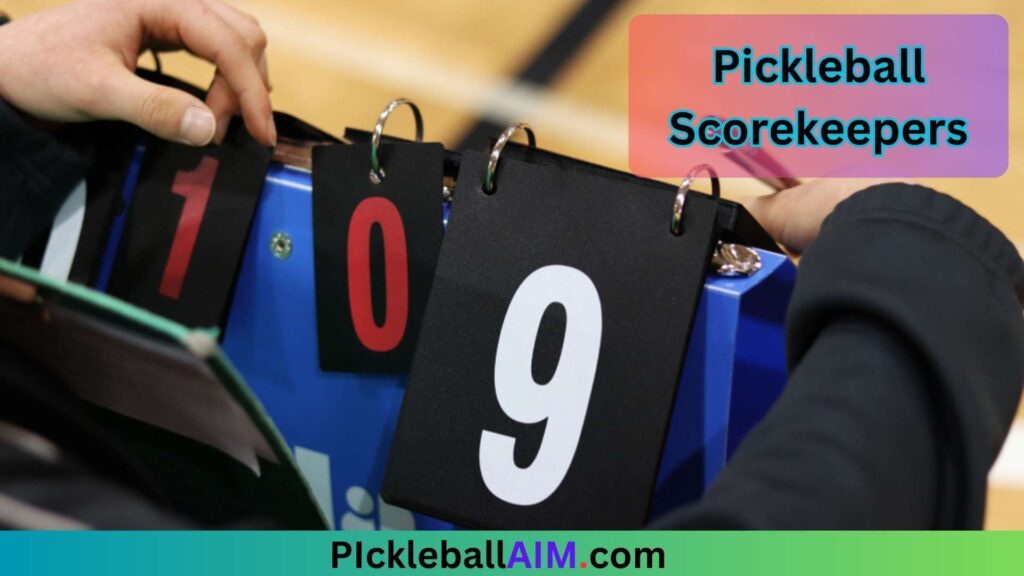
Pickleball scorekeepers are devices or tools used by players to keep track of the score during pickleball games. These devices come in various forms and designs, all aimed at making the scoring process more accessible, accurate, and efficient. The importance of scorekeepers lies in their ability to prevent confusion, disputes, and disruptions during gameplay, allowing players to focus on the game without worrying about the score.
Purpose of Pickleball Scorekeepers:
The primary purpose of pickleball scorekeepers is to maintain an accurate record of the score throughout the match. In pickleball, the scoring system can be a bit unique and may vary depending on whether you are playing singles or doubles. It is essential to keep track of the score correctly to determine the winner of each game and ultimately the overall winner of the match.
Types of Pickleball Scorekeepers:
There are several types of scorekeepers available to suit different preferences and playing environments:
- Manual Scorekeepers: These are simple devices that usually consist of a two-sided board or flip cards. Players manually update the score after each point by flipping the numbers to reflect the current score.
- Electronic Scoreboards: Electronic scorekeepers are more advanced and often used in tournaments or professional matches. They have digital displays that automatically update the score as points are won.
- Paddle Score Trackers: Some pickleball paddles come with integrated score tracking mechanisms. Players slide a button or dial on the handle to adjust the score, which eliminates the need for a separate device.
Advantages of Using Pickleball Scorekeepers:
- Accuracy: Scorekeepers help ensure the accuracy of the score, reducing the risk of errors or disagreements between players.
- Convenience: Scorekeepers make it easy for players to keep track of the score without relying on memory or constantly asking their opponents for the score.
- Focus on the Game: With a scorekeeper, players can stay focused on the game, leading to a smoother and more enjoyable playing experience.
- Fair Play: By eliminating score-related disputes, scorekeepers promote fair play and sportsmanship among players.
How to Use Pickleball Scorekeepers:
Using a scorekeeper is usually straightforward:
- Manual Scorekeepers: Players or a designated scorekeeper update the score manually by flipping the numbers after each point. For doubles play, both teams should agree on the score before each serve.
- Electronic Scoreboards: Electronic scoreboards automatically update the score as points are won, requiring no manual input from the players. They may be operated by a designated scorer or connected to the referee’s table in professional matches.
- Paddle Score Trackers: If players are using paddles with built-in score tracking, they simply adjust the score using the integrated mechanism after each point.
Conclusion
pickleball scorekeepers play a crucial role in maintaining an accurate and smooth scoring process during games. Whether it’s a simple manual scorekeeper or an advanced electronic scoreboard, these devices contribute to the overall enjoyment and fairness of the sport by eliminating score-related disputes and allowing players to concentrate on the game itself.
FAQs
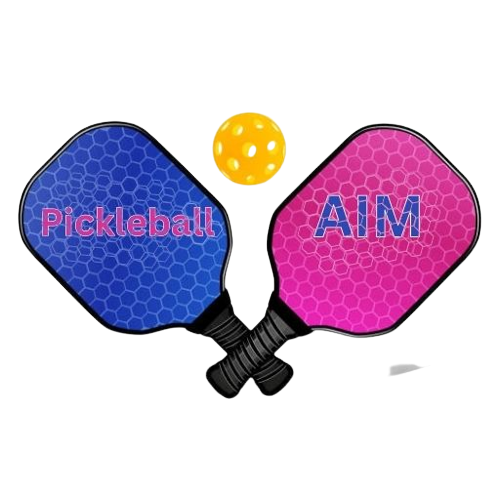
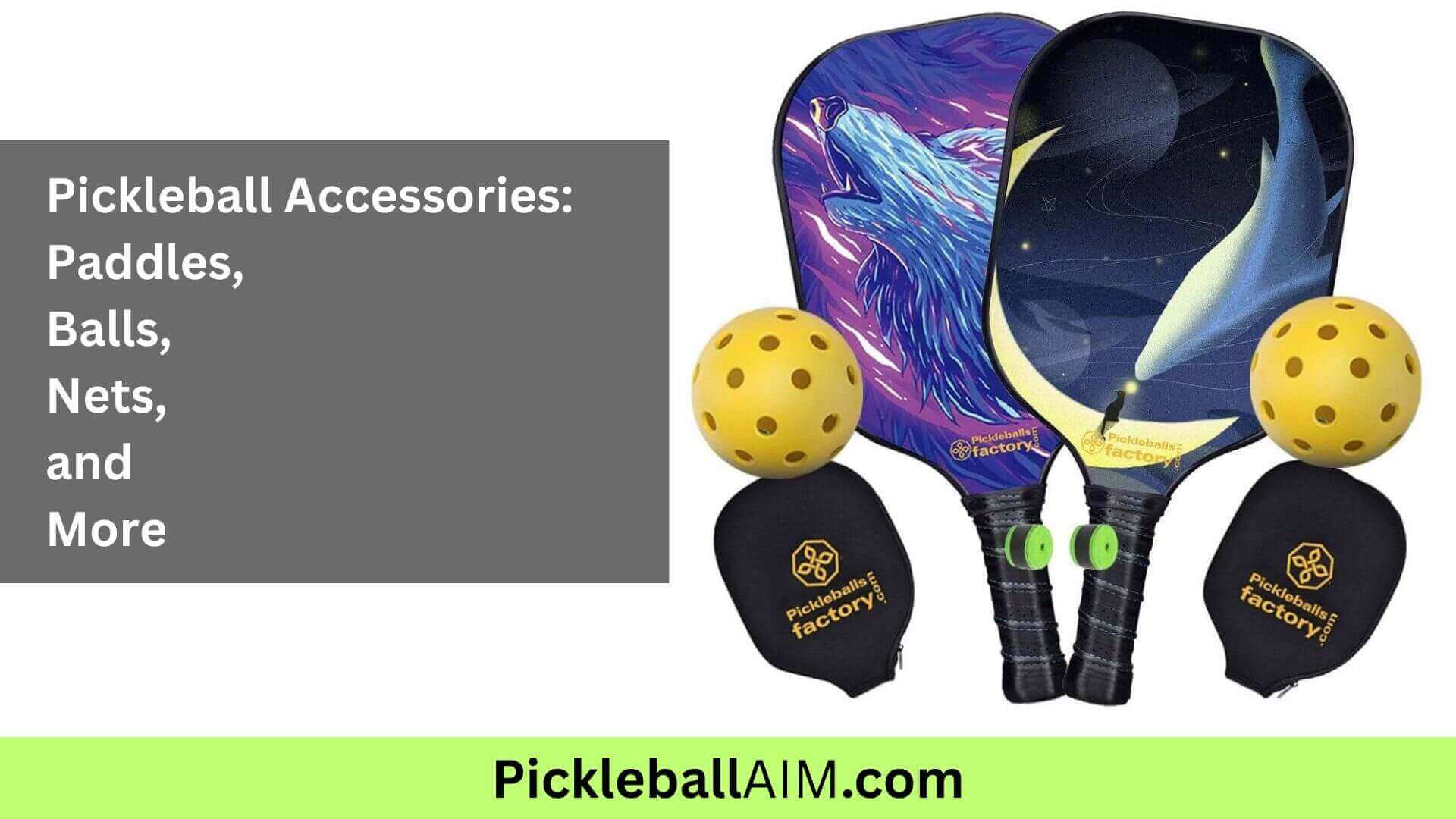
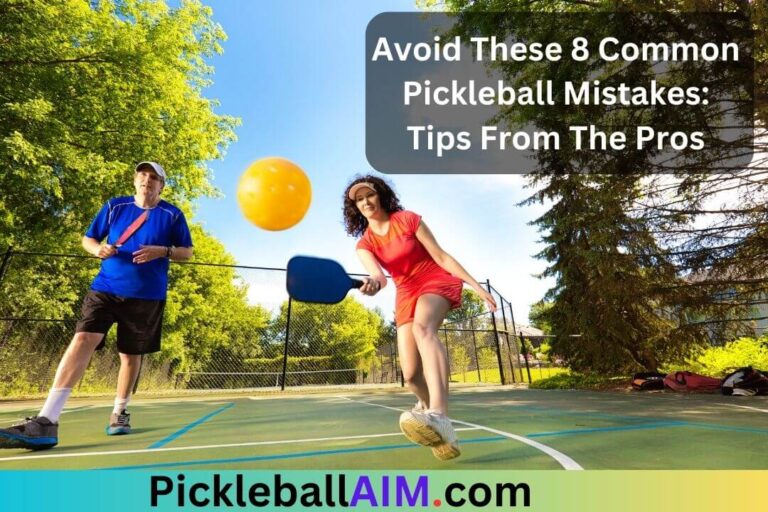

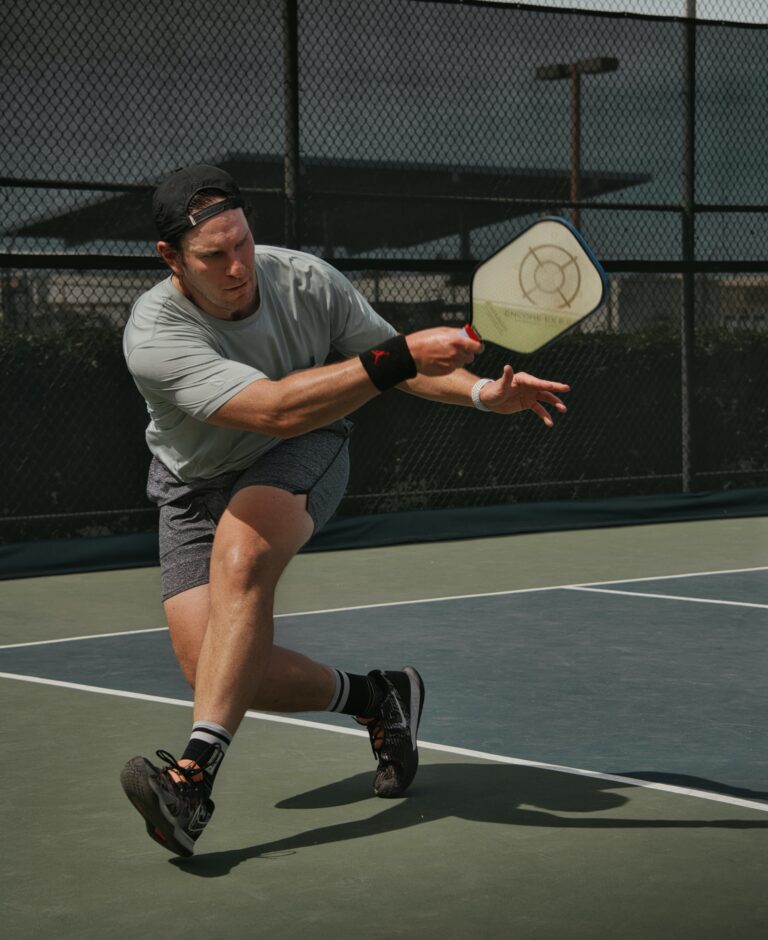
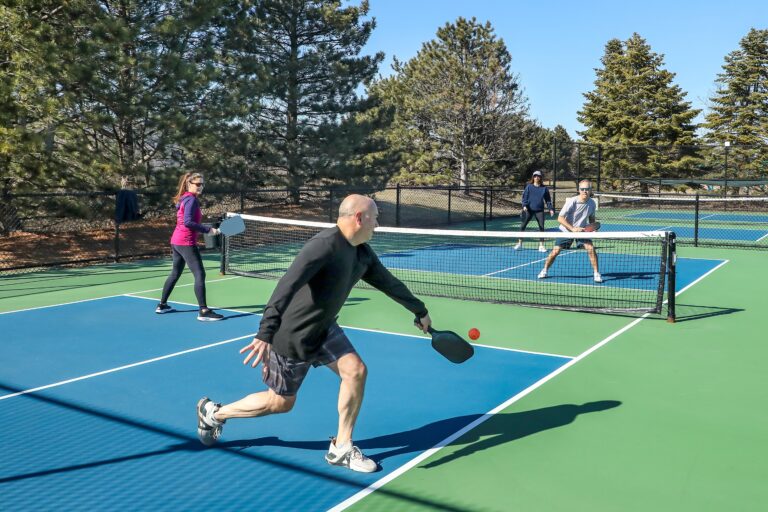
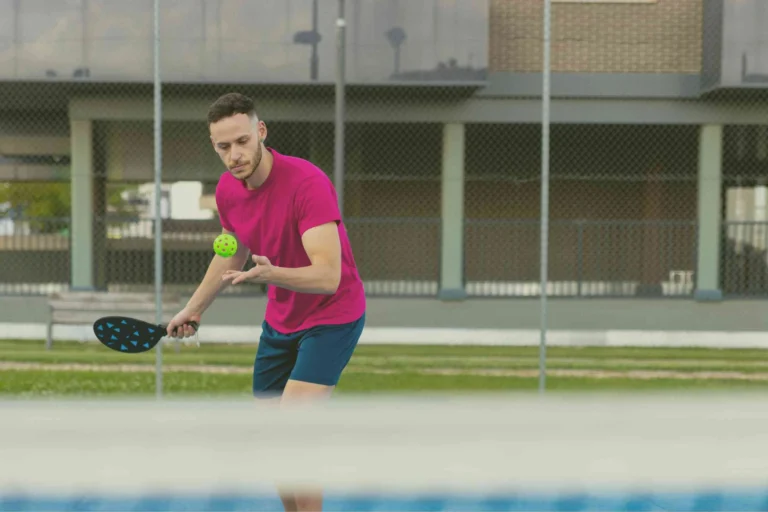
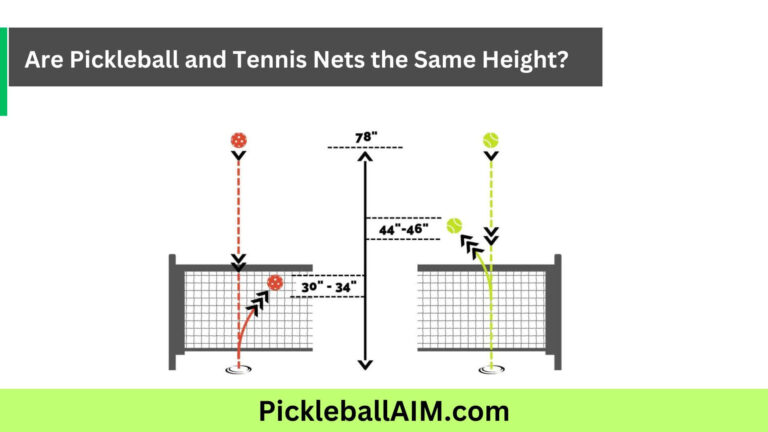
8 Comments